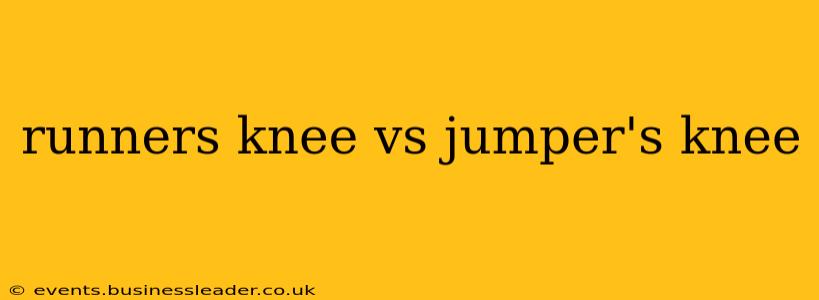Both runner's knee and jumper's knee are common knee pain conditions, often causing confusion due to their similar names. While both involve pain around the kneecap (patella), they stem from different overuse mechanisms and often affect different areas of the knee joint. This comprehensive guide will clarify the key distinctions between these two conditions.
What is Runner's Knee?
Runner's knee, also known as patellofemoral pain syndrome (PFPS), is a condition characterized by pain around the kneecap. It's frequently associated with activities that involve repetitive impact and stress on the knees, like running, cycling, or stair climbing. The pain is often felt at the front of the knee, sometimes radiating to the sides or behind the kneecap.
The underlying cause isn't always a single injury, but rather a combination of factors that irritate the cartilage under the kneecap and the tissues surrounding it. These factors can include:
- Muscle imbalances: Weakness in the quadriceps (thigh muscles), particularly the vastus medialis obliquus (VMO), can lead to improper tracking of the kneecap, increasing stress on the joint.
- Overpronation: This refers to excessive inward rolling of the foot during running, which can misalign the leg and knee.
- Tight muscles: Tight hamstrings and hip flexors can restrict movement and increase stress on the knee.
- Patellar malalignment: In some cases, the kneecap may be naturally misaligned, predisposing individuals to PFPS.
- Overtraining or sudden increase in activity: Gradually increasing running intensity and distance is crucial to prevent knee injuries.
What is Jumper's Knee?
Jumper's knee, or patellar tendinitis, is a condition specifically affecting the tendon that connects the kneecap (patella) to the shinbone (tibia). This tendon is crucial for extending the knee, and repetitive jumping movements place significant stress on it. The pain is typically located below the kneecap, at the point where the tendon attaches to the tibia.
Unlike runner's knee, jumper's knee often presents with a more localized and intense pain, particularly during and after jumping activities. Symptoms can include:
- Pain below the kneecap: The pain is typically sharp and focused on this area.
- Tenderness to the touch: The area below the kneecap may be tender when pressed.
- Stiffness: The knee may feel stiff, especially in the morning or after periods of inactivity.
- Swelling: In some cases, mild swelling may be present.
Runner's Knee vs. Jumper's Knee: Key Differences Summarized
| Feature | Runner's Knee (PFPS) | Jumper's Knee (Patellar Tendinitis) |
|---|---|---|
| Location of Pain | Front and around the kneecap | Below the kneecap |
| Cause | Multiple factors, including muscle imbalances, overpronation, and patellar malalignment | Repetitive jumping, overuse of the patellar tendon |
| Activities | Running, cycling, stair climbing | Jumping, volleyball, basketball |
| Type of Pain | Aching, diffuse pain | Sharp, localized pain |
How are Runner's Knee and Jumper's Knee Diagnosed?
Both conditions are usually diagnosed through a physical examination. Your doctor will assess your symptoms, examine your knee, and assess your range of motion. Imaging tests such as X-rays may be used to rule out other conditions, but are often not necessary for a diagnosis.
What is the Treatment for Runner's Knee and Jumper's Knee?
Treatment for both runner's knee and jumper's knee typically involves conservative measures, including:
- Rest: Avoiding activities that aggravate the pain.
- Ice: Applying ice packs to reduce inflammation.
- Compression: Using a compression bandage to support the knee.
- Elevation: Keeping the leg elevated to reduce swelling.
- Physical therapy: Strengthening exercises to improve muscle balance and flexibility, particularly focusing on quadriceps and hamstring strengthening.
- Pain medication: Over-the-counter pain relievers like ibuprofen or naproxen can help manage pain and inflammation.
- Orthotics: Custom-made or over-the-counter orthotics can help correct foot alignment and reduce stress on the knee (particularly helpful for runner's knee).
In more severe cases, your doctor may recommend:
- Corticosteroid injections: These injections can help reduce inflammation but are not a long-term solution.
- Surgery: Surgery is rarely necessary for either condition and is usually only considered as a last resort if conservative treatment fails.
Can I prevent Runner's Knee and Jumper's Knee?
Prevention is key! Here are some strategies:
- Warm-up properly: Always warm up before any activity.
- Stretch regularly: Stretch your quadriceps, hamstrings, and hip flexors.
- Strengthen your muscles: Focus on strengthening exercises for the quadriceps and other supporting leg muscles.
- Wear supportive footwear: Choose shoes appropriate for your activity and foot type.
- Gradually increase activity levels: Avoid sudden increases in intensity or duration of exercise.
- Listen to your body: Rest when you need to and don't push through pain.
This information is intended for educational purposes only and does not constitute medical advice. It's essential to consult with a healthcare professional for diagnosis and treatment of any knee pain. They can properly assess your specific condition and recommend the most appropriate course of action.
